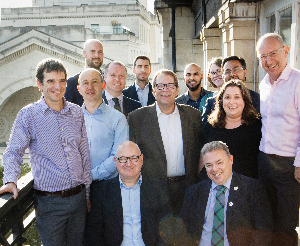
Submitted by Angela Walters on Fri, 02/11/2018 - 12:15
CDBB and the Chartered Institute of Building (CIOB) teamed up for the second event in a programme of high-level ‘roundtable’ discussions, which aim to further accelerate adoption of the Government’s digital strategy for the built environment, especially the successful embedment of BIM across industry.
Involving significant industry figures from the UK and from around the globe, this second roundtable focused on the role of the ‘Constructor’ in the digital built environment. The constructor participants were also joined by members of the CDBB team [as facilitators] and the Public Sector BIM Working Group, including Met Police and Thames Tideway, who procure constructor supply chains.
The Tier 1 contractors were, on the whole, positive about BIM, with those around the table stating that they are doing BIM internally as business as usual, whether the client requests it or not. However, where a client is not participating in the BIM process, the contractors are delivering in BIM to mitigate their delivery risk, rather than any consideration of exploiting the data to add additional value to their current service delivery.
Overall the ‘why are you adopting BIM’ varied – from it's generally a tender requirement, ‘money to the bottom line’ was quoted, as well as adopting it as a response to the Grenfell Tower fire and the Dame Judith Hackitt report. All felt the clients they work with still have much work to do in developing comprehensive OIRs and AIRs if we are to truly create a ‘golden thread’ of information. The consensus was that if clients had such documents and better levels of engagement [as promoted by a soft landings approach] it would allow them to focus on data that will support improved business decisions, enhanced asset management and ultimately better performance outcomes.
Capability and capacity of skilled and knowledgeable digital workers was still seen as a constraint in driving BIM adoption and need for academia to be producing new  entrants with these qualities. Some of the organisations around the table had undertaken skills reviews and highlighted new skill sets are increasingly required that include data experts, coders / app developers, gamming programmers etc. It was agreed that we need a more joined up training and academic approach to BIM.
entrants with these qualities. Some of the organisations around the table had undertaken skills reviews and highlighted new skill sets are increasingly required that include data experts, coders / app developers, gamming programmers etc. It was agreed that we need a more joined up training and academic approach to BIM.
There was a good discussion around the BIM baseline of Level 1 maturity and the need to get the information management foundation blocks in place for Level 2 to build upon. Positively what was referred to on the day as ‘vanilla BIM’ was seen as something that is cost neutral to provide to clients.
There was agreement that ‘elephant in the room’ was beyond delivery, especially Facilities Management [FM] providers who were thought not to be engaging sufficiently to deliver benefits of data down-stream into operations.
Overall it was a positive message from the constructors around the BIM agenda and between them the participating organisations have many 100s of BIM projects that are delivering real value. It was also evident that other themes are starting to converge with BIM, especially sensor technologies and augmented reality.
A full article from the roundtable will be published in the January edition of Construction Manager magazine and in BIMplus.
